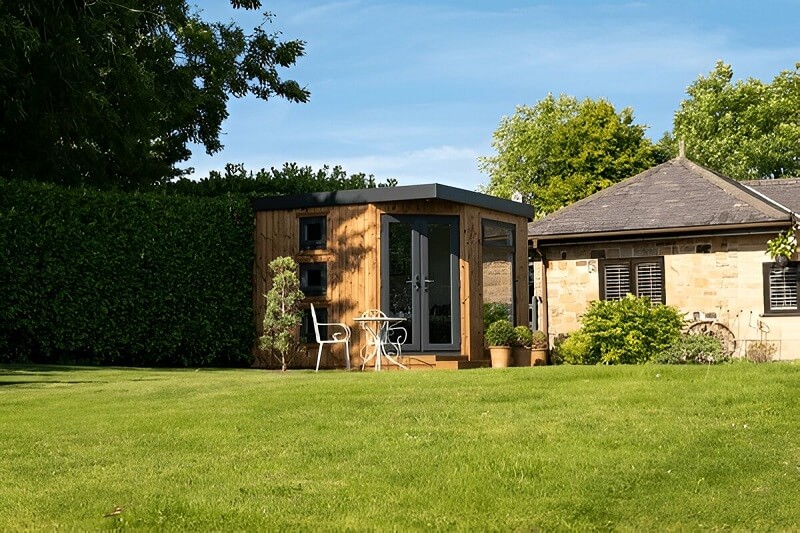Even the smallest city garden can become a pocket of calm if you let nature lead the way.
It’s not about grandeur but about intention, balance, and a bit of clever planning.
With a few thoughtful choices, a once-forgotten patch can grow into something rather lovely.
Start with What You’ve Got

Every garden has its quirks, even the most compact urban patch.
Before lifting a spade or choosing plants, spend a little time simply observing. Where does the
sun fall in the morning? Which spots stay shaded all day? These quiet details help shape a
space that works with nature, not against it.
Soil plays a vital part too. A gentle dig will reveal whether it’s light and crumbly or stubborn and
compacted. Most city gardens benefit from a top-up of compost or organic matter to get things
going.
If it all feels a bit unfamiliar, local landscapers can lend a hand. They know how to assess the
space, provide tailored suggestions, and steer you away from expensive missteps.
More than anything, think about what you actually want from your garden. Somewhere peaceful
to sit, a veg patch, or a flower-filled hideaway? Once you’ve decided what matters most, you
can start planning with confidence and a bit of flair.
Choose Plants That Practically Care for Themselves
The most successful city gardens are typically the ones that demand the least. That’s not to say
they lack charm, only that they’ve been filled with plants that are comfortable in their
surroundings and don’t require constant attention.
Native species are an excellent place to begin. They’re built for local weather, understand the
soil, and often thrive with little more than a bit of sun and occasional watering.
Hardy herbs, meadow flowers, and drought-tolerant grasses look good while keeping fuss to a
minimum.
You can also group plants with similar light and water needs to streamline care. That way, you
won’t find yourself watering one side while the other sulks from overwatering.
And if you’re unsure where to start, your nearest nursery or community garden usually knows
which plants flourish in your part of the world.
The added bonus? Native and low-maintenance plants attract bees, butterflies, and birds,
turning your garden into a gentle hum of life that evolves with the seasons.
Think Upwards, Not Outwards

Limited space is no reason to hold back.
When square footage is in short supply, vertical gardening offers a practical and stylish solution.
From climbing beans to trailing nasturtiums, many plants grow happily upwards if given the
chance.
Trellises, mounted planters, and hanging baskets can all be used to turn plain walls and fences
into green backdrops. Moreover, upcycled materials like old crates or timber offcuts bring
character and keep costs down.
Just make sure structures are secure and that plants have enough sunlight and room to grow.
Vertical setups aren’t just clever; they’re also tidy. They free up ground space, reduce weed
growth, and make watering easier. The result is a layered, dynamic garden that feels fuller and
more established, even when space is tight.
With a touch of creativity, even a balcony or modest courtyard can become a lush, upward-
growing retreat.
Turn Kitchen Scraps into Garden Gold
Composting is one of those quietly brilliant habits that pays off in all the right ways.
It cuts down on waste, reduces reliance on shop-bought fertilisers, and enriches your soil with
nutrients your plants will absolutely love.
Start with a simple compost bin or heap in a corner of the garden. Add vegetable peelings,
coffee grounds, eggshells, grass clippings, and dry leaves.
The trick is to keep the mix balanced—roughly equal parts wet and dry matter—and to turn it
now and then so air can circulate.
If you’re working with limited space, worm composting is a smart, compact alternative. Worms
break down food scraps into rich castings, which are perfect for feeding plants in pots or
borders. It’s clean, efficient, and surprisingly odour-free.
Composting can even be a family affair. Children often enjoy helping and learning about the
natural cycles at play!
It’s a small act with a lasting impact, and the resulting compost will quietly improve everything
that grows from it.
Make Every Drop of Water Count
City gardening commonly means working with restrictions, and water can be one of them.
Collecting rainwater is an easy, environmentally friendly way to keep your plants hydrated
without over-relying on the tap.
Position a large barrel or water butt beneath a downpipe and let nature do the rest. Fitting a lid
keeps insects and leaves out, while a simple mesh screen helps prevent debris build-up.
Moreover, you can add a tap near the base, and you’ve got a self-serve supply ready for dry
spells.
Placing the barrel in a shaded spot keeps the water cooler and clearer. If you’re feeling
organised, connect a few drip lines to direct water straight to plant roots.
This saves time, avoids overwatering, and ensures every drop ends up where it’s needed most.
Rainwater, being naturally soft and free of chemicals, is particularly well suited to sensitive
plants. It’s a small change, but one that brings lasting benefits to your garden and the
environment alike.
Invite Nature In, Let Wildlife Stay
More than just a place for people, an urban garden can serve as a wildlife sanctuary.
Encouraging pollinators and other helpful visitors supports local biodiversity and brings the
garden to life in charming and often unexpected ways.
Choose flowers that bloom across the seasons, so there’s always a source of nectar. Think
lavender, foxglove, marjoram, and echinacea. The more variety, the more bees and butterflies
will linger.
Avoid chemical sprays where possible. Natural pest control—such as companion planting or
homemade solutions—keeps plants healthy without harming the creatures you’re trying to
attract.
Even a patch of nettles or a few untamed corners can offer nesting and shelter for insects.
Furthermore, bird feeders and bee hotels are easy additions that go a long way. A shallow dish
of water with a few stones becomes a much-appreciated drink station.
These thoughtful touches create a space that feels lived in, not just by you, but by the wider
ecosystem as well.
And let’s be honest, the quiet joy of spotting a robin or watching bees bumble about is one of
gardening’s greatest, most underrated pleasures.
Conclusion
A city garden may start small, but its influence reaches wide.
With care, clever choices, and a touch of imagination, it becomes a living part of your home. So
take your time, dig in, and watch something beautiful take root.







